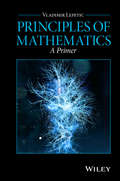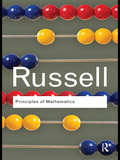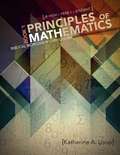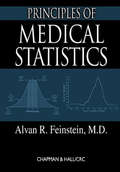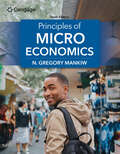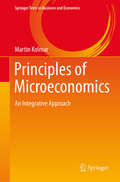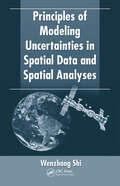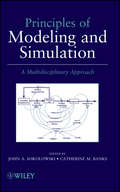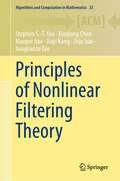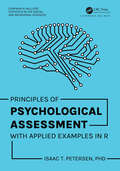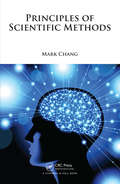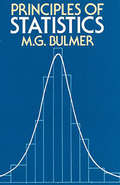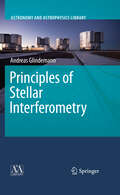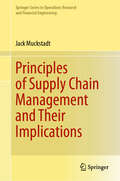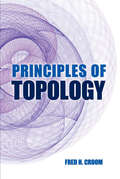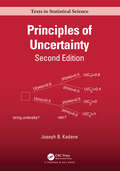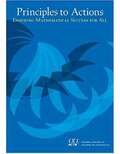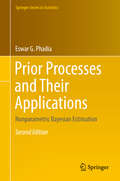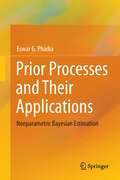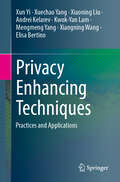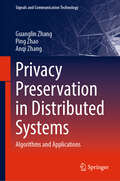- Table View
- List View
Principles of Mathematics
by Vladimir LepeticPresents a uniquely balanced approach that bridges introductory and advanced topics in modern mathematics An accessible treatment of the fundamentals of modern mathematics, Principles of Mathematics: A Primer provides a unique approach to introductory andadvanced mathematical topics. The book features six main subjects, whichcan be studied independently or in conjunction with each other including: settheory; mathematical logic; proof theory; group theory; theory of functions; andlinear algebra. The author begins with comprehensive coverage of the necessary building blocks in mathematics and emphasizes the need to think abstractly and develop an appreciation for mathematical thinking. Maintaining a useful balance of introductory coverage and mathematical rigor, Principles of Mathematics: A Primer features: Detailed explanations of important theorems and their applications Hundreds of completely solved problems throughout each chapter Numerous exercises at the end of each chapter to encourage further exploration Discussions of interesting and provocative issues that spark readers' curiosity and facilitate a better understanding and appreciation of the field of mathematics Principles of Mathematics: A Primer is an ideal textbook for upper-undergraduate courses in the foundations of mathematics and mathematical logic as well as for graduate-level courses related to physics, engineering, and computer science. The book is also a useful reference for readers interested in pursuing careers in mathematics and the sciences. Vladimir Lepetic, PhD, is Professor in the Department of Mathematical Sciences at DePaul University. His research interests include mathematical physics, set theory, foundations of mathematics, and the philosophy of mathematics.
Principles of Mathematics (Routledge Classics)
by Bertrand RussellFirst published in 1903, Principles of Mathematics was Bertrand Russell’s first major work in print. It was this title which saw him begin his ascent towards eminence. In this groundbreaking and important work, Bertrand Russell argues that mathematics and logic are, in fact, identical and what is commonly called mathematics is simply later deductions from logical premises. Highly influential and engaging, this important work led to Russell’s dominance of analytical logic on western philosophy in the twentieth century.
Principles of Mathematics: Book 1
by Katherine A. LoopThis is Year 1 of a two-year math course designed to give students a firm mathematical foundation, both academically and spiritually. Not only does the curriculum build mathematical thinking and problem-solving skills, it also shows students how a biblical worldview affects our approach to math's various concepts. Students learn to see math, not as an academic exercise, but as a way of exploring and describing consistencies God created and sustains. The worldview is not just an addition to the curriculum, but the starting point. Science, history, and real life are integrated throughout.
Principles of Medical Statistics
by Alvan R. FeinsteinThe get-it-over-with-quickly approach to statistics has been encouraged - and often necessitated - by the short time allotted to it in most curriculums. If included at all, statistics is presented briefly, as a task to be endured mainly because pertinent questions may appear in subsequent examinations for licensure or other certifications. However,
Principles of Microeconomics
by N. Gregory MankiwProvide an inviting, superbly written introduction to microeconomics that allows all types of students to quickly grasp microeconomic concepts and build a strong foundation. The most widely-used learning solution in economics classrooms worldwide, written by acclaimed author and economist Gregory Mankiw, PRINCIPLES OF MICROECONOMICS, 9E focuses on the most important microeconomic principles to avoid overwhelming students with excessive detail. Extensive updates, relevant contemporary examples and carefully crafted content present the understanding your students need at key moments in your course. This edition works seamlessly with the latest MindTap digital course solutions and powerful student-focused resources, featuring the highly acclaimed Graph Builder and enhanced Adaptive Test Prep. A team of award-winning teaching economists have further strengthened this edition's leading ancillary support with more relevance, engagement, and interactive learning opportunities.
Principles of Microeconomics
by N. Gregory MankiwIntroduce microeconomics using the inviting, reader-friendly approach in PRINCIPLES OF MICROECONOMICS, 10E by acclaimed author and economist Gregory Mankiw. The most widely-used learning solution in economics classrooms worldwide, this edition is designed to guide all types of learners to a strong foundation in microeconomics with the latest updates, interactive practice and current examples. Carefully crafted content focuses on the most important microeconomic principles to avoid overwhelming students with excessive detail. The author presents the background students need at key moments in your course. This edition works seamlessly with the latest MindTap digital course solutions and student-focused resources. A leading support package by award-winning teaching economists with Aplia homework solutions and author videos provides additional relevance and interactive learning opportunities.
Principles of Microeconomics: An Integrative Approach (Springer Texts in Business and Economics)
by Martin KolmarThis text provides a comprehensive and unique introduction to modern microeconomics. It pursues an integrative approach by putting the main findings of economics into a broader perspective; theories are critically reflected on from a philosophical standpoint and by comparing them to approaches found in the social sciences, while implications for the design of the legal system and business practices are highlighted throughout. In addition, the book presents brief examples and comprehensive case studies to facilitate an understanding of the theories’ real-world implications.Starting from the question as to why and how societies organize economic activity, the book adopts an institutional perspective to analyze the potential and limitations of different market types with regard to alleviating scarcity and achieving distributive objectives.It not only covers traditional rational-choice models, but also systematically introduces readers to important findings from behavioral economics and psychology.A companion workbook is available which features a wide variety of exercises, ranging from basic multiple-choice questions to challenging mathematical problems and case study scenarios.
Principles of Modeling Uncertainties in Spatial Data and Spatial Analyses
by Wenzhong ShiWhen compared to classical sciences such as math, with roots in prehistory, and physics, with roots in antiquity, geographical information science (GISci) is the new kid on the block. Its theoretical foundations are therefore still developing and data quality and uncertainty modeling for spatial data and spatial analysis is an important branch of t
Principles of Modeling and Simulation
by Catherine M. Banks John A. SokolowskiExplores wide-ranging applications of modeling and simulation techniques that allow readers to conduct research and ask "What if??"Principles of Modeling and Simulation: A Multidisciplinary Approach is the first book to provide an introduction to modeling and simulation techniques across diverse areas of study. Numerous researchers from the fields of social science, engineering, computer science, and business have collaborated on this work to explore the multifaceted uses of computational modeling while illustrating their applications in common spreadsheets.The book is organized into three succinct parts:Principles of Modeling and Simulation provides a brief history of modeling and simulation, outlines its many functions, and explores the advantages and disadvantages of using models in problem solving. Two major reasons to employ modeling and simulation are illustrated through the study of a specific problem in conjunction with the use of related applications, thus gaining insight into complex concepts.Theoretical Underpinnings examines various modeling techniques and introduces readers to two significant simulation concepts: discrete event simulation and simulation of continuous systems. This section details the two primary methods in which humans interface with simulations, and it also distinguishes the meaning, importance, and significance of verification and validation.Practical Domains delves into specific topics related to transportation, business, medicine, social science, and enterprise decision support. The challenges of modeling and simulation are discussed, along with advanced applied principles of modeling and simulation such as representation techniques, integration into the application infrastructure, and emerging technologies.With its accessible style and wealth of real-world examples, Principles of Modeling and Simulation: A Multidisciplinary Approach is a valuable book for modeling and simulation courses at the upper-undergraduate and graduate levels. It is also an indispensable reference for researchers and practitioners working in statistics, mathematics, engineering, computer science, economics, and the social sciences who would like to further develop their understanding and knowledge of the field.
Principles of Nonlinear Filtering Theory (Algorithms and Computation in Mathematics #33)
by Stephen S.-T. Yau Xiuqiong Chen Xiaopei Jiao Jiayi Kang Zeju Sun Yangtianze TaoThis text presents a comprehensive and unified treatment of nonlinear filtering theory, with a strong emphasis on its mathematical underpinnings. It is tailored to meet the needs of a diverse readership, including mathematically inclined engineers and scientists at both graduate and post-graduate levels. What sets this book apart from other treatments of the topic is twofold. Firstly, it offers a complete treatment of filtering theory, providing readers with a thorough understanding of the subject. Secondly, it introduces updated methodologies and applications that are crucial in today’s landscape. These include finite-dimensional filters, the Yau-Yau algorithm, direct methods, and the integration of deep learning with filtering problems. The book will be an invaluable resource for researchers and practitioners for years to come. With a rich historical backdrop dating back to Gauss and Wiener, the exposition delves into the fundamental principles underpinning the estimation of stochastic processes amidst noisy observations—a critical tool in various applied domains such as aircraft navigation, solar mapping, and orbit determination, to name just a few. Substantive exercises and examples given in each chapter provide the reader with opportunities to appreciate applications and ample ways to test their understanding of the topics covered. An especially nice feature for those studying the subject independent of a traditional course setting is the inclusion of solutions to exercises at the end of the book. The book is structured into three cohesive parts, each designed to build the reader's understanding of nonlinear filtering theory. In the first part, foundational concepts from probability theory, stochastic processes, stochastic differential equations, and optimization are introduced, providing readers with the necessary mathematical background. The second part delves into theoretical aspects of filtering theory, covering topics such as the stochastic partial differential equation governing the posterior density function of the state, and the estimation algebra theory of systems with finite-dimensional filters. Moving forward, the third part of the book explores numerical algorithms for solving filtering problems, including the Yau-Yau algorithm, direct methods, classical filtering algorithms like the particle filter, and the intersection of filtering theory with deep learning.
Principles of Optimal Design
by Douglass J. Wilde Panos Y. PapalambrosPrinciples of Optimal Design puts the concept of optimal design on a rigorous foundation and demonstrates the intimate relationship between the mathematical model that describes a design and the solution methods that optimize it. Since the first edition was published, computers have become ever more powerful, design engineers are tackling more complex systems, and the term optimization is now routinely used to denote a design process with increased speed and quality. This second edition takes account of these developments and brings the original text thoroughly up to date. The book now includes a discussion of trust region and convex approximation algorithms. A new chapter focuses on how to construct optimal design models. Three new case studies illustrate the creation of optimization models. The final chapter on optimization practice has been expanded to include computation of derivatives, interpretation of algorithmic results, and selection of algorithms and software. Both students and practising engineers will find this book a valuable resource for design project work.
Principles of Psychological Assessment: With Applied Examples in R (Chapman & Hall/CRC Statistics in the Social and Behavioral Sciences)
by Isaac T. PetersenThis book highlights the principles of psychological assessment to help researchers and clinicians better develop, evaluate, administer, score, integrate, and interpret psychological assessments. It discusses psychometrics (reliability and validity), the assessment of various psychological domains (behavior, personality, intellectual functioning), various measurement methods (e.g., questionnaires, observations, interviews, biopsychological assessments, performance-based assessments), and emerging analytical frameworks to evaluate and improve assessment including: generalizability theory, structural equation modeling, item response theory, and signal detection theory. The text also discusses ethics, test bias, and cultural and individual diversity.Key Features Gives analysis examples using free software Helps readers apply principles to research and practice Provides text, analysis code/syntax, R output, figures, and interpretations integrated to guide readers Uses the freely available petersenlab package for R Principles of Psychological Assessment: With Applied Examples in R is intended for use by graduate students, faculty, researchers, and practicing psychologists.
Principles of Scientific Methods
by Mark ChangThis book focuses on the fundamental principles behind scientific methods. The author uses concrete examples to explain principles. He also uses analogies to connect different methods or problems to arrive at a general principle or common notion. The book explores how the principles of scientific methods are not only applicable to scientific research but also in our daily lives. It shows how the scientific method is used to understand how and why things happen, make predictions, prevent mistakes, and solve problems.
Principles of Statistical Inference
by D. R. CoxIn this definitive book, D. R. Cox gives a comprehensive and balanced appraisal of statistical inference. He develops the key concepts, describing and comparing the main ideas and controversies over foundational issues that have been keenly argued for more than two-hundred years. Continuing a sixty-year career of major contributions to statistical thought, no one is better placed to give this much-needed account of the field. An appendix gives a more personal assessment of the merits of different ideas. The content ranges from the traditional to the contemporary. While specific applications are not treated, the book is strongly motivated by applications across the sciences and associated technologies. The mathematics is kept as elementary as feasible, though previous knowledge of statistics is assumed. The book will be valued by every user or student of statistics who is serious about understanding the uncertainty inherent in conclusions from statistical analyses.
Principles of Statistics
by M. G. BulmerThere are many textbooks which describe current methods of statistical analysis, while neglecting related theory. There are equally many advanced textbooks which delve into the far reaches of statistical theory, while bypassing practical applications. But between these two approaches is an unfilled gap, in which theory and practice merge at an intermediate level. Professor M. G. Bulmer's Principles of Statistics, originally published in 1965, was created to fill that need. The new, corrected Dover edition of Principles of Statistics makes this invaluable mid-level text available once again for the classroom or for self-study. Principles of Statistics was created primarily for the student of natural sciences, the social scientist, the undergraduate mathematics student, or anyone familiar with the basics of mathematical language. It assumes no previous knowledge of statistics or probability; nor is extensive mathematical knowledge necessary beyond a familiarity with the fundamentals of differential and integral calculus. (The calculus is used primarily for ease of notation; skill in the techniques of integration is not necessary in order to understand the text.)Professor Bulmer devotes the first chapters to a concise, admirably clear description of basic terminology and fundamental statistical theory: abstract concepts of probability and their applications in dice games, Mendelian heredity, etc.; definitions and examples of discrete and continuous random variables; multivariate distributions and the descriptive tools used to delineate them; expected values; etc. The book then moves quickly to more advanced levels, as Professor Bulmer describes important distributions (binomial, Poisson, exponential, normal, etc.), tests of significance, statistical inference, point estimation, regression, and correlation. Dozens of exercises and problems appear at the end of various chapters, with answers provided at the back of the book. Also included are a number of statistical tables and selected references.
Principles of Stellar Interferometry
by Andreas GlindemannThe imaging process in stellar interferometers is explained starting from first principles on wave propagation and diffraction. Wave propagation through turbulence is described in detail using Kolmogorov statistics. The impact of turbulence on the imaging process is discussed both for single telescopes and for interferometers. Correction methods (adaptive optics and fringe tracking) are presented including wavefront sensing/fringe sensing methods and closed loop operation. Instrumental techniques like beam combination and visibility measurements (modulus and phase) as well as Nulling and heterodyne interferometry are described. The book closes with examples of observing programmes linking the theory with individual astrophysical programmes.
Principles of Supply Chain Management and Their Implications (Springer Series in Operations Research and Financial Engineering)
by Jack MuckstadtThe text begins with a discussion of the basic principles of supply chain management and some attributes of certain industries. The remainder of the text is devoted to developing and applying mathematical concepts needed to address the many issues associated with managing supply chains and, in particular, uncertainty, in a variety of real world settings. In particular, the final chapter is devoted to the design and operation of a vaccine distribution system during a pandemic along with a critique of the way the system used in the United States performed.
Principles of Topology (Dover Books on Mathematics)
by Fred H. CroomTopology is a natural, geometric, and intuitively appealing branch of mathematics that can be understood and appreciated by students as they begin their study of advanced mathematical topics. Designed for a one-semester introduction to topology at the undergraduate and beginning graduate levels, this text is accessible to students familiar with multivariable calculus. Rigorous but not abstract, the treatment emphasizes the geometric nature of the subject and the applications of topological ideas to geometry and mathematical analysis.Customary topics of point-set topology include metric spaces, general topological spaces, continuity, topological equivalence, basis, subbasis, connectedness, compactness, separation properties, metrization, subspaces, product spaces, and quotient spaces. In addition, the text introduces geometric, differential, and algebraic topology. Each chapter includes historical notes to put important developments into their historical framework. Exercises of varying degrees of difficulty form an essential part of the text.
Principles of Uncertainty (Chapman & Hall/CRC Texts in Statistical Science)
by Joseph B. KadanePraise for the first edition: Principles of Uncertainty is a profound and mesmerising book on the foundations and principles of subjectivist or behaviouristic Bayesian analysis. … the book is a pleasure to read. And highly recommended for teaching as it can be used at many different levels. … A must-read for sure!—Christian Robert, CHANCEIt's a lovely book, one that I hope will be widely adopted as a course textbook.—Michael Jordan, University of California, Berkeley, USALike the prize-winning first edition, Principles of Uncertainty, Second Edition is an accessible, comprehensive text on the theory of Bayesian Statistics written in an appealing, inviting style, and packed with interesting examples. It presents an introduction to the subjective Bayesian approach which has played a pivotal role in game theory, economics, and the recent boom in Markov Chain Monte Carlo methods. This new edition has been updated throughout and features new material on Nonparametric Bayesian Methods, the Dirichlet distribution, a simple proof of the central limit theorem, and new problems.Key Features: First edition won the 2011 DeGroot Prize Well-written introduction to theory of Bayesian statistics Each of the introductory chapters begins by introducing one new concept or assumption Uses "just-in-time mathematics"—the introduction to mathematical ideas just before they are applied
Principles to Actions: Ensuring Mathematical Success for All
by National Council of Teachers of MathematicsWhat it will take to turn the opportunity of the Common Core into reality in every classroom, school, and district. <p><p> Continuing its tradition of mathematics education leadership, NCTM has undertaken a major initiative to define and describe the principles and actions, including specific teaching practices, that are essential for a high-quality mathematics education for all students. <p> This landmark new title offers guidance to teachers, mathematics coaches, administrators, parents, and policymakers: <p> Provides a research-based description of eight essential Mathematics Teaching Practices <p> Describes the conditions, structures, and policies that must support the Teaching Practices <p> Builds on NCTM's Principles and Standards for School Mathematics and supports implementation of the Common Core State Standards for Mathematics to attain much higher levels of mathematics achievement for all students <p> Identifies obstacles, unproductive and productive beliefs, and key actions that must be understood, acknowledged, and addressed by all stakeholders <p> Encourages teachers of mathematics to engage students in mathematical thinking, reasoning, and sense making to significantly strengthen teaching and learning
Prior Processes and Their Applications
by Eswar G. PhadiaThis book presents a systematic and comprehensive treatment of various prior processes that have been developed over the past four decades for dealing with Bayesian approach to solving selected nonparametric inference problems. This revised edition has been substantially expanded to reflect the current interest in this area. After an overview of different prior processes, it examines the now pre-eminent Dirichlet process and its variants including hierarchical processes, then addresses new processes such as dependent Dirichlet, local Dirichlet, time-varying and spatial processes, all of which exploit the countable mixture representation of the Dirichlet process. It subsequently discusses various neutral to right type processes, including gamma and extended gamma, beta and beta-Stacy processes, and then describes the Chinese Restaurant, Indian Buffet and infinite gamma-Poisson processes, which prove to be very useful in areas such as machine learning, information retrieval and featural modeling. Tailfree and Polya tree and their extensions form a separate chapter, while the last two chapters present the Bayesian solutions to certain estimation problems pertaining to the distribution function and its functional based on complete data as well as right censored data. Because of the conjugacy property of some of these processes, most solutions are presented in closed form. However, the current interest in modeling and treating large-scale and complex data also poses a problem - the posterior distribution, which is essential to Bayesian analysis, is invariably not in a closed form, making it necessary to resort to simulation. Accordingly, the book also introduces several computational procedures, such as the Gibbs sampler, Blocked Gibbs sampler and slice sampling, highlighting essential steps of algorithms while discussing specific models. In addition, it features crucial steps of proofs and derivations, explains the relationships between different processes and provides further clarifications to promote a deeper understanding. Lastly, it includes a comprehensive list of references, equipping readers to explore further on their own.
Prior Processes and Their Applications: Nonparametric Bayesian Estimation
by Eswar G. PhadiaThis book presents a systematic and comprehensive treatment of various prior processes that have been developed over the last four decades in order to deal with the Bayesian approach to solving some nonparametric inference problems. Applications of these priors in various estimation problems are presented. Starting with the famous Dirichlet process and its variants, the first part describes processes neutral to the right, gamma and extended gamma, beta and beta-Stacy, tail free and Polya tree, one and two parameter Poisson-Dirichlet, the Chinese Restaurant and Indian Buffet processes, etc., and discusses their interconnection. In addition, several new processes that have appeared in the literature in recent years and which are off-shoots of the Dirichlet process are described briefly. The second part contains the Bayesian solutions to certain estimation problems pertaining to the distribution function and its functional based on complete data. Because of the conjugacy property of some of these processes, the resulting solutions are mostly in closed form. The third part treats similar problems but based on right censored data. Other applications are also included. A comprehensive list of references is provided in order to help readers explore further on their own.
Prisoners of Reason
by S. m. AmadaeIs capitalism inherently predatory? Must there be winners and losers? Is public interest outdated and free-riding rational? Is consumer choice the same as self-determination? Must bargainers abandon the no-harm principle? Prisoners of Reason recalls that classical liberal capitalism exalted the no-harm principle. Although imperfect and exclusionary, modern liberalism recognized individual human dignity alongside individuals' responsibility to respect others. Neoliberalism, by contrast, views life as ceaseless struggle. Agents vie for scarce resources in antagonistic competition in which every individual seeks dominance. This political theory is codified in non-cooperative game theory; the neoliberal citizen and consumer is the strategic rational actor. Rational choice justifies ends irrespective of means. Money becomes the medium of all value. Solidarity and good will are invalidated. Relationships are conducted on a quid pro quo basis. However, agents can freely opt out of this cynical race to the bottom by embracing a more expansive range of coherent action.
Privacy Enhancing Techniques: Practices and Applications
by Elisa Bertino Xun Yi Kwok-Yan Lam Xuechao Yang Andrei Kelarev Xiaoning Liu Mengmeng Yang Xiangning WangThis book provides a comprehensive exploration of advanced privacy-preserving methods, ensuring secure data processing across various domains. This book also delves into key technologies such as homomorphic encryption, secure multiparty computation, and differential privacy, discussing their theoretical foundations, implementation challenges, and real-world applications in cloud computing, blockchain, artificial intelligence, and healthcare. With the rapid growth of digital technologies, data privacy has become a critical concern for individuals, businesses, and governments. The chapters cover fundamental cryptographic principles and extend into applications in privacy-preserving data mining, secure machine learning, and privacy-aware social networks. By combining state-of-the-art techniques with practical case studies, this book serves as a valuable resource for those navigating the evolving landscape of data privacy and security. Designed to bridge theory and practice, this book is tailored for researchers and graduate students focused on this field. Industry professionals seeking an in-depth understanding of privacy-enhancing technologies will also want to purchase this book.
Privacy Preservation in Distributed Systems: Algorithms and Applications (Signals and Communication Technology)
by Anqi Zhang Ping Zhao Guanglin ZhangThis book provides a discussion of privacy in the following three parts: Privacy Issues in Data Aggregation; Privacy Issues in Indoor Localization; and Privacy-Preserving Offloading in MEC. In Part 1, the book proposes LocMIA, which shifts from membership inference attacks against aggregated location data to a binary classification problem, synthesizing privacy preserving traces by enhancing the plausibility of synthetic traces with social networks. In Part 2, the book highlights Indoor Localization to propose a lightweight scheme that can protect both location privacy and data privacy of LS. In Part 3, it investigates the tradeoff between computation rate and privacy protection for task offloading a multi-user MEC system, and verifies that the proposed load balancing strategy improves the computing service capability of the MEC system. In summary, all the algorithms discussed in this book are of great significance in demonstrating the importance of privacy.
